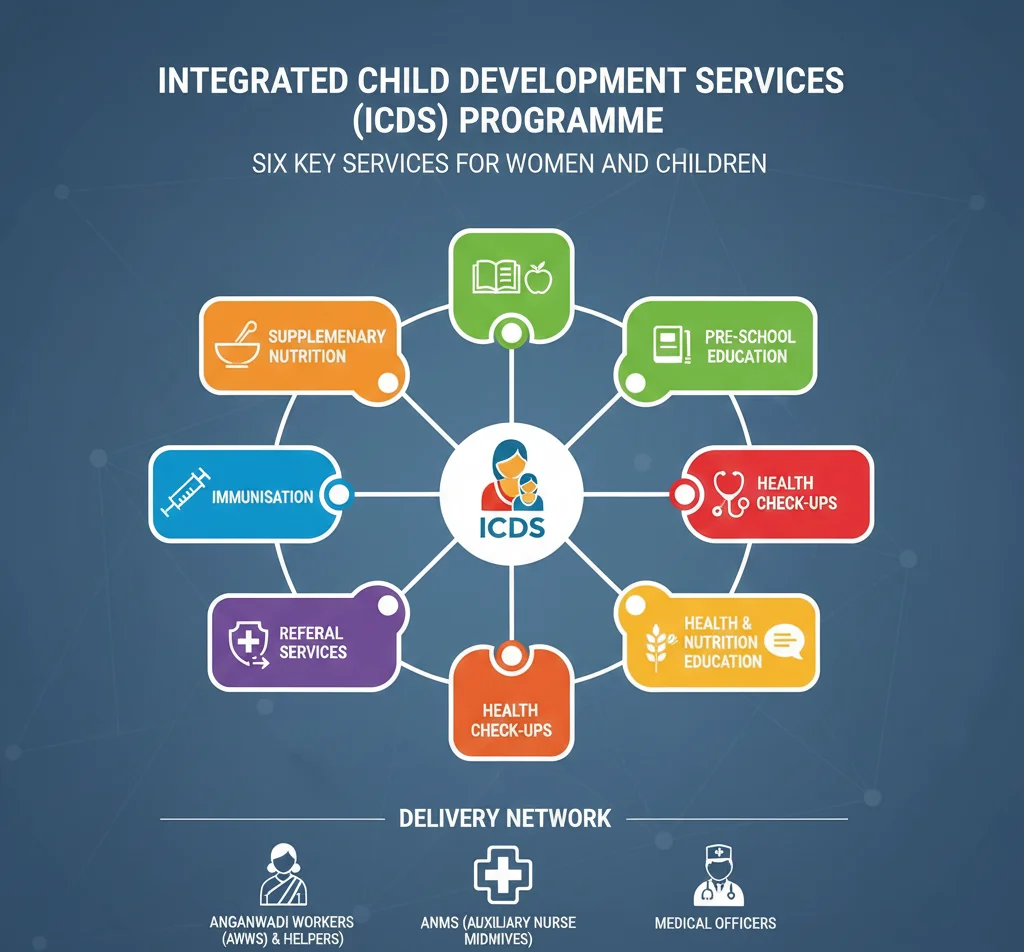Important Facts For Prelims
Integrated Child Development Services (ICDS) Programme
- 26 Nov 2025
- 6 min read
Why in News?
The Integrated Child Development Services (ICDS) programme has completed 50 years since its launch as a pilot in Karnataka, one of its earliest adopters, the programme now is the world’s largest community-based early childhood development programme.
What is the Integrated Child Development Services (ICDS) Programme?
- About: The ICDS is a centrally sponsored flagship programme launched on 2nd October 1975, anchored by the Ministry of Women and Child Development (MoWCD) to improve the nutrition, health, and early learning outcomes of children aged 0–6 years, along with pregnant and lactating mothers.
- ICDS has now been revised and subsumed under 'Mission Saksham Anganwadi & Poshan 2.0'.
- Objectives: Improve health and nutritional status of children (0–6 years).
- Lay the foundation for psychological, physical, and social development.
- Reduce child mortality, morbidity, malnutrition, and school dropouts.
- Strengthen interdepartmental coordination for child development.
- Services offered under ICDS:
- Significance: ICDS is vital for early childhood development as it tackles malnutrition, improves health outcomes.
- It provides a safety net for pregnant and lactating mothers, reducing mortality and supporting maternal health.
- By integrating nutrition, health, and education services at the community level, it strengthens human capital, reduces inter-generational poverty, and supports women’s participation in the workforce.
Mission Saksham Anganwadi & Poshan 2.0
- About: In FY 2021-22, Saksham Anganwadi and POSHAN 2.0 was launched as India’s flagship Integrated Nutrition Support Programme that integrates key child and maternal welfare programmes like ICDS, Poshan Abhiyan, the Scheme for Adolescent Girls, and the National Crèche Scheme.
- Approved for implementation during the 15th Finance Commission period (2021–26), it aims to strengthen nutrition, early childhood care, and overall support for women and children.
- Major Verticals:
- Supplementary Nutrition for children (6 months–6 years), pregnant women, lactating mothers, and adolescent girls (14–18 years) in Aspirational Districts and the Northeast.
- Early Childhood Care & Education (ECCE) for children aged 3–6, with early stimulation for ages 0–3.
- Upgradation of Anganwadi Infrastructure, including modern Saksham Anganwadi centres.
- Poshan Abhiyaan, the national convergence mission for a malnutrition-free India.
- Special Focus Areas: Improving maternal nutrition and Infant and Young Child Feeding (IYCF), alongside introducing treatment protocols for SAM and MAM supported by AYUSH wellness practices.
- The scheme strengthens real-time nutrition monitoring through the Poshan Tracker, and prioritises adolescent girls’ nutrition through the Scheme for Adolescent Girls (SAG), which targets 14–18-year-olds in priority regions.
Frequently Asked Questions (FAQs)
Q. What is ICDS?
ICDS (Integrated Child Development Services) is a centrally sponsored flagship programme that provides an integrated package — supplementary nutrition, pre-school education, immunisation, health check-ups, referral services and health & nutrition education — for children (0–6 years) and pregnant/lactating mothers.
Q. What is Mission Saksham Anganwadi & POSHAN 2.0?
It is the restructured umbrella programme that subsumes ICDS, Poshan Abhiyaan, Scheme for Adolescent Girls and National Crèche Scheme to strengthen nutrition, ECCE, anganwadi infrastructure and adolescent nutrition through convergence and digital monitoring (Poshan Tracker).
Q. How does Poshan Tracker help programme delivery?
Poshan Tracker enables real-time monitoring of nutrition indicators, beneficiary tracking and convergence with RCH data, improving targeting and accountability
UPSC Civil Services Examination Previous Year Question (PYQ)
Prelims
Q. Which of the following are the objectives of ‘National Nutrition Mission’? (2017)
- To create awareness relating to malnutrition among pregnant women and lactating mothers.
- To reduce the incidence of anaemia among young children, adolescent girls and women.
- To promote the consumption of millets, coarse cereals and unpolished rice.
- To promote the consumption of poultry eggs.
Select the correct answer using the code given below:
(a) 1 and 2 only
(b) 1, 2 and 3 only
(c) 1, 2 and 4 only
(d) 3 and 4 only
Ans: (a)








